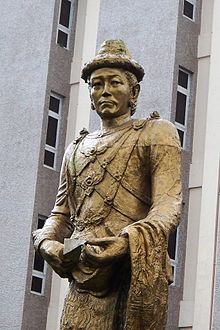Alaungpaya
| Alaungpaya အလောင်းဘုရား |
|||||
|---|---|---|---|---|---|

Statue of King Alaungpaya in front of the National Museum of Myanmar in Yangon
|
|||||
| King of Burma | |||||
| Reign | 29 February 1752 – 11 May 1760 | ||||
| Coronation | 17 April 1752 | ||||
| Predecessor | Mahadhammaraza Dipadi | ||||
| Successor | Naungdawgyi | ||||
| Born | 24 August [O.S. 13 August] 1714 Friday, 1st waning of Tawthalin 1076 ME Moksobo |
||||
| Died | 11 May 1760 (aged 45) Sunday, 12th waning of Kason 1122 ME Kinywa, Martaban |
||||
| Burial | May 1760 Shwebo |
||||
| Consort | Yun San | ||||
| Issue among others... |
Naungdawgyi Hsinbyushin Bodawpaya |
||||
|
|||||
| House | Konbaung | ||||
| Father | Min Nyo San | ||||
| Mother | Saw Nyein Oo | ||||
| Religion | Theravada Buddhism | ||||
| Full name | |
|---|---|
| Aung Zeya အောင်ဇေယျ |
Alaungpaya (Burmese: အလောင်းဘုရား, pronounced: [ʔəláʊɴ pʰəjá]; also spelled Alaunghpaya or Alaung Phra; 24 August [O.S. 13 August] 1714 – 11 May 1760) was the founder of the Konbaung Dynasty of Burma (Myanmar). By the time of his death from illness during his campaign in Siam, this former chief of a small village in Upper Burma had unified Burma, subdued Manipur, conquered Lan Na and driven out the French and the British who had given help to the Mon Restored Hanthawaddy Kingdom. He also founded Yangon in 1755.
He is considered one of the three greatest monarchs of Burma alongside Anawrahta and Bayinnaung for unifying Burma for the third time in Burmese history.
The future king was born Aung Zeya (အောင်ဇေယျ "Victorious Victory") at Moksobo, a village of a few hundred households in the Mu River Valley about 60 miles northwest of Ava on 24 August 1714 to Min Nyo San (မင်းညိုစံ) and his wife Saw Nyein Oo (စောငြိမ်းဦး). He was the second son of a lineage of gentry families that had administered the Mu Valley for generations. His father was a hereditary chief of Moksobo and his uncle, Kyawswa Htin (ကျော်စွာထင်), better known as Sitha Mingyi (စည်သာမင်းကြီး), was the lord of the Mu Valley District. Alaungpaya claimed descent from kings Narapati I and Thihathura and ultimately the Pagan royal line. He came from a large family, and was related by blood and by marriage to many other gentry families throughout the valley. In 1730, Alaungpaya married his first cousin Yun San (ယွန်းစံ), daughter of chief of a neighboring village, Siboktara (စည်ပုတ္တရာ). They went on to have six sons and three surviving daughters. (The fourth daughter died young.)
...
Wikipedia
